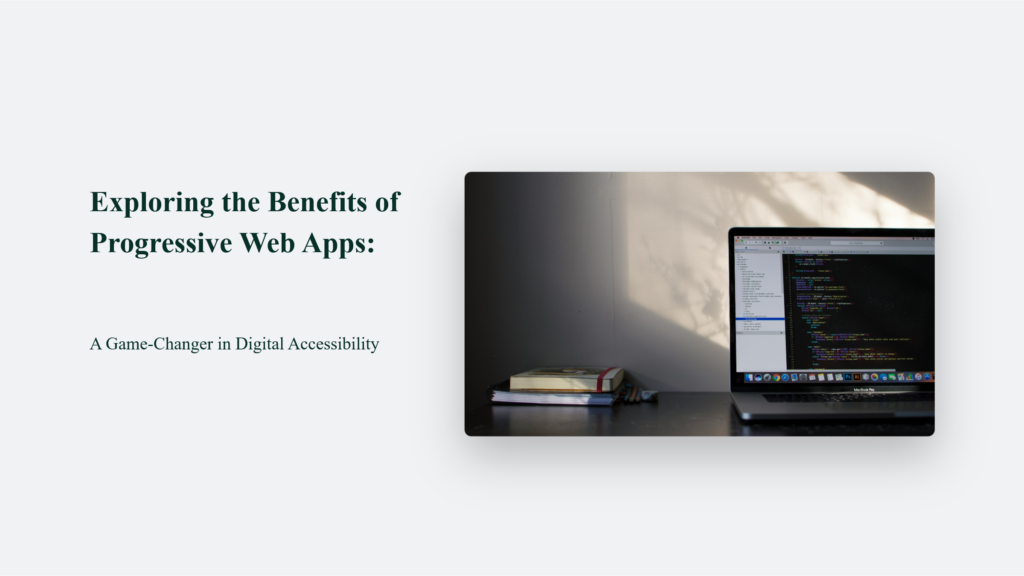

Exploring the Benefits of Progressive Web Apps: A Game-Changer in Digital Accessibility

As Seen On
In the ever-evolving landscape of digital technology, businesses and developers are constantly on the lookout for innovative solutions that enhance user experience and streamline development processes.
Enter Progressive Web Apps (PWAs), a hybrid breed of regular web pages and mobile applications that promise to revolutionize how we interact with our favourite digital services. But what exactly makes PWAs so transformative?
Let’s delve into their myriad benefits, backed by compelling anecdotes, insightful opinions, and robust data.

What Are Progressive Web Apps?
Progressive Web Apps are essentially websites that offer a mobile app’s functionality and seamless user experience. They are designed to work on any platform using a standards-compliant browser, including desktop and mobile devices.
The beauty of PWAs lies in their ability to provide an app-like experience — offline access, push notifications, and fast load times — without downloading and installing software from an app store.
The Seamless Intersection of Web and Mobile
Progressive Web Apps (PWAs) are redefining the boundaries between web and mobile experiences, offering a seamless intersection that enhances user engagement and accessibility.
This innovative technology allows websites to function like mobile apps, providing a cohesive and intuitive user experience across various devices without separate downloads or installations.
The Convergence of Web and Mobile through PWAs
For example, Twitter’s PWA, Twitter Lite, is designed to operate efficiently by loading quickly and using minimal data. It makes it an excellent choice for users with limited internet connectivity or who are frequently mobile.
Key Features of PWAs
- App-Like Interface: PWAs provide features such as smooth animations, responsive navigation, and interaction that mimic the feel of native apps.
- Offline Functionality: Service workers enable PWAs to load and function offline or in poor network conditions, making them reliable anytime, anywhere.
- No Installation Required: Unlike traditional apps, PWAs don’t require users to visit an app store. Users can simply add them to their home screen from their browser, enhancing convenience.
- Fast Performance: PWAs are optimized for speed, ensuring quick loading times even on slower connections, which is crucial for maintaining user engagement.
Benefits of the Web-Mobile Hybrid
The integration of web and mobile features within PWAs offers several advantages:
- Broader Accessibility: Since PWAs can be accessed through any web browser, they are not limited by device type or operating system, broadening the potential user base.
- Cost-Effective Development: Developing a PWA is generally less expensive than creating separate apps for different platforms, as it involves a single codebase that runs everywhere.
- Enhanced User Retention: The ease of access, combined with high performance and offline capabilities, helps retain users who might not be willing to download a full mobile app due to storage constraints or data usage concerns.
Real-World Impact
Businesses across various industries are adopting PWAs to leverage their unique benefits. E-commerce platforms, news outlets, and financial services are just a few sectors where PWAs have significantly impacted user experience and engagement while reducing development and maintenance costs.
Key Benefits of Progressive Web Apps
Progressive Web Apps (PWAs) have emerged as a game-changing technology, offering a seamless blend of web and mobile app experiences. By leveraging modern web capabilities, PWAs deliver various benefits that transform the digital landscape. Here are some of the key advantages that make PWAs a compelling choice:
Enhanced User Experience
PWAs are engineered to be lightning-fast, leveraging cutting-edge web technologies to deliver high performance and reliability. A Google study found that PWAs have the potential to load 2-3 times faster than traditional mobile apps. This speed enhancement significantly improves user satisfaction and engagement, providing a smooth, responsive experience that keeps users hooked.
Offline Accessibility
One of the most compelling features of PWAs is their ability to function offline or on low-quality networks. This is made possible through service workers—scripts that run in the background and manage the caching of the application shell. This means that users can access their favourite PWA even when they’re flying high in the skies or traversing remote areas with spotty internet coverage, ensuring uninterrupted access to essential services and content.
Cost-Effective Development
Developing a PWA is generally less expensive than creating a native app. With PWAs, developers write their code once and deploy it everywhere, which cuts down development costs and simplifies the update process. Businesses can save on development and maintenance costs while still providing a top-tier app experience to their users, making PWAs an attractive option for companies of all sizes.
Increased Engagement and Conversion Rates
PWAs have been shown to significantly increase engagement and conversion rates. For example, after upgrading its site to a PWA, Alibaba, the world’s largest online B2B trading platform, saw a staggering 76% increase in conversions across browsers. The ability to send push notifications and the advantage of an icon on the home screen keep users connected and engaged, fostering a deeper connection with the brand.
Platform Agnostic
Regardless of the operating system, PWAs are designed to work seamlessly across various platforms and devices, including desktops, tablets, and smartphones. This platform-agnostic nature ensures a consistent user experience and eliminates the need to develop separate apps for different platforms, further reducing development costs and maintenance efforts.
Improved Performance
PWAs leverage service workers and JavaScript files that run separately from the main browser thread to control asset caching proactively. This approach performs better than traditional web apps, ensuring smooth scrolling, responsive interfaces, and faster load times, even on slow or unreliable networks.
Seamless Updates
Unlike native apps that require manual updates, PWAs automatically update themselves whenever users visit the website. This seamless update process eliminates the need for users to manually install updates, reducing friction and ensuring they always have access to the latest features and bug fixes without any additional effort.
The Bottom Line:
In conclusion, progressive web apps represent a significant leap forward in how we conceive and interact with the web. They blend the best features of web and mobile apps, offering businesses a powerful tool to enhance user engagement and streamline development processes. As we continue to push the boundaries of what’s possible in digital spaces, PWAs stand out as a beacon of innovation and efficiency.
Frequently Asked Questions:
What is the main technology behind PWAs?
PWAs primarily rely on service workers, manifest files, and responsive design to deliver a seamless, app-like experience on the web.
Can PWAs replace native apps?
While PWAs can perform many of the same functions as native apps, they might not entirely replace native apps due to limitations in accessing certain device functionalities and hardware.
How do I convert my existing website into a PWA?
Converting a website into a PWA involves implementing service workers for offline capabilities, creating a web app manifest, and ensuring the site is served over HTTPS.
Konger
Up until working with Casey, we had only had poor to mediocre experiences outsourcing work to agencies. Casey & the team at CJ&CO are the exception to the rule.
Communication was beyond great, his understanding of our vision was phenomenal, and instead of needing babysitting like the other agencies we worked with, he was not only completely dependable but also gave us sound suggestions on how to get better results, at the risk of us not needing him for the initial job we requested (absolute gem).
This has truly been the first time we worked with someone outside of our business that quickly grasped our vision, and that I could completely forget about and would still deliver above expectations.
I honestly can't wait to work in many more projects together!
Disclaimer
*The information this blog provides is for general informational purposes only and is not intended as financial or professional advice. The information may not reflect current developments and may be changed or updated without notice. Any opinions expressed on this blog are the author’s own and do not necessarily reflect the views of the author’s employer or any other organization. You should not act or rely on any information contained in this blog without first seeking the advice of a professional. No representation or warranty, express or implied, is made as to the accuracy or completeness of the information contained in this blog. The author and affiliated parties assume no liability for any errors or omissions.

